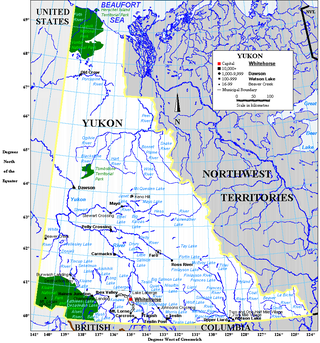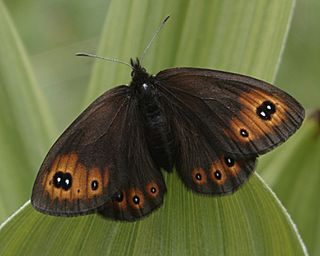
The Alaska Range is a relatively narrow, 600-mile-long (950 km) mountain range in the southcentral region of the U.S. state of Alaska, from Lake Clark at its southwest end to the White River in Canada's Yukon Territory in the southeast. Denali, the highest mountain in North America, is in the Alaska Range. The range is part of the American Cordillera.

The Canadian Rockies or Canadian Rocky Mountains, comprising both the Alberta Rockies and the British Columbian Rockies, is the Canadian segment of the North American Rocky Mountains. It is the easternmost part of the Canadian Cordillera, which is the northern segment of the North American Cordillera, the expansive system of interconnected mountain ranges between the Interior Plains and the Pacific Coast that runs northwest–southeast from central Alaska to the Isthmus of Tehuantepec in Mexico.

The gray-crowned rosy finch or gray-crowned rosy-finch is a species of passerine bird in the family Fringillidae native to Alaska, western Canada, and the north-western United States. Due to its remote and rocky alpine habitat it is rarely seen. There are currently six recognized subspecies. It is one of four species of rosy finches.

Yukon is in the northwestern corner of Canada and is bordered by Alaska, British Columbia and the Northwest Territories. The sparsely populated territory abounds with natural scenery, snowmelt lakes and perennial white-capped mountains, including many of Canada's highest mountains. The territory's climate is Arctic in territory north of Old Crow, subarctic in the region, between Whitehorse and Old Crow, and humid continental climate south of Whitehorse and in areas close to the British Columbia border. Most of the territory is boreal forest with tundra being the main vegetation zone only in the extreme north and at high elevations.

Erebia is a Holarctic genus of brush-footed butterflies, family Nymphalidae. Most of the about 90–100 species are dark brown or black in color, with reddish-brown to orange or more rarely yellowish wing blotches or bands. These usually bear black spots within, which sometimes have white center spots.

Erebia euryale, the large ringlet, is a species of butterfly belonging to the family Nymphalidae.

Erebia epipsodea, the common alpine, is a butterfly species of the subfamily Satyrinae of family Nymphalidae. It is found in North America from Alaska south through the Rocky Mountains to northern New Mexico and east across the prairie provinces to southwest Manitoba.

Erebia callias, the Colorado alpine, is a member of the Satyridae subfamily of the Nymphalidae butterflies. It is found in alpine areas of Wyoming and Colorado in the U.S. Rocky Mountains as well as various mountain ranges in eastern Asia.

Erebia rossii, the Arctic alpine or Ross's alpine, is a member of the subfamily Satyrinae of the family Nymphalidae. It is found in Arctic North America and northern Eurasia.
Erebia lafontainei, the reddish alpine or Lafontaine's alpine, is a member of the subfamily Satyrinae of the family Nymphalidae. It is found in northern North America from Alaska, Yukon, and western Northwest Territories as far east as Tuktoyuktuk.
The four-dotted alpine is a member of the subfamily Satyrinae of the family Nymphalidae. It is found in the north of North America from Alaska, western Yukon, and east in the Northwest Territories as far as Fort McPherson and Tuktoyuktuk.
Erebia pawloskii, commonly known as the yellow-dotted alpine, is a member of the subfamily Satyrinae of the family Nymphalidae. It is found in North America in northern British Columbia, Yukon, and Alaska. It is also found in the Sayan Mountains, and from northern Mongolia to Yakutia and Kamchatka. The habitat consists of grassy areas in and above wet tundra, as well as bogs.

Erebia discoidalis, the red-disked alpine, is a member of the subfamily Satyrinae of family Nymphalidae. It is found in North America from eastern Quebec, through northern Ontario, and the northern Prairies to northern British Columbia, the Northwest Territories, Yukon, and Alaska. It reaches just into the northern U.S. between Michigan and Montana, and also occurs in Asia, where it has been recorded from the Chukot Peninsula to the eastern Sayan Mountains and Amur. The habitat consists of large, open, grassy bogs and other areas with acidic soils.

Erebia fasciata, the banded alpine, is a member of the subfamily Satyrinae of family Nymphalidae. It is found from central Siberia, through Alaska, Yukon, and mainland Northwest Territories and Nunavut to Hudson Bay. It also occurs on Banks Island and Victoria Island.
Erebia mackinleyensis, the Mt. McKinley alpine, is a butterfly in the subfamily Satyrinae of the family Nymphalidae. It is found from eastern Siberia through Alaska and Yukon, just reaching into the Northwest Territories in the Richardson Mountains and into British Columbia at Stone Mountain Provincial Park.
The Magdalena alpine is a member of the subfamily Satyrinae of the family Nymphalidae. It is found in North America from Montana, Colorado, Utah, and New Mexico, and in Canada in a small part of the Willmore Wilderness Park, Alberta, and adjacent British Columbia, in Stone Mountain Provincial Park in northern British Columbia, and on an isolated nunatak in Kluane National Park and Reserve, Yukon. The habitat consists of rockslides near vegetation, at or above the treeline.
Erebia mancinus, the taiga alpine, is a member of the subfamily Satyrinae of the family Nymphalidae. It lives in subarctic North America from Labrador, northern Quebec, and northern Ontario, through the northern Prairie Provinces, northern British Columbia, and the interior of the Northwest Territories to Yukon and Alaska. It also ranges south in the mountains as far as Banff, Alberta. The habitat consists of black spruce-sphagnum bogs.

Juncus triglumis, called the three-flowered rush, is a species of flowering plant in the genus Juncus, native to the subarctic and subalpine Northern Hemisphere. It is typically found in calcareous tundra habitats and arcto-alpine fens. It is often found in association with Carex atrofusca and Carex bicolor in the so-called Caricion bicolori-atrofuscae alliance.











